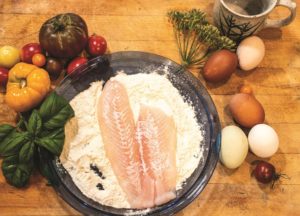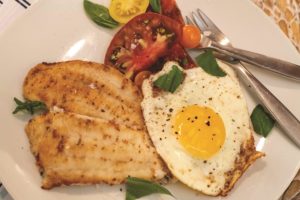Cooking with friends who also love to cook puts things right for me. It’s like when musicians jam — we play, become inspired, and riff on classics, and our payoff is eating very well. When we visit my dear friend and cookbook collaborator, Kathy Gunst, and her husband, John Rudolph, I can count on all our meals being wonderful.
On a stay at their place in southern Maine, one breakfast made a lasting impression. In a pre-caffeinated state, I had followed the smell of deeply roasted coffee to find Kathy puttering around her kitchen. She pulled a shiny white paper bundle from the fridge, then pulled the paper back to reveal pristine fillets of sole. I thought, “Ahh, prepping something for lunch.” We are always thinking at least one meal ahead.

She cracked farm eggs into her seasoned cast-iron skillet and dropped a healthy knob of butter in another. There was not a strip of bacon in sight. After seasoning the fish with a generous pinch of coarse salt and a turn of fresh pepper, she gave it a light dusting of flour and laid the fillets in the sizzling butter. The fish crackled, yolks shone in the black skillet, toast popped. Within minutes, golden sole slid onto our plates, right and cozy next to the sunny eggs.
Of course, this wasn’t my first encounter with fish for breakfast. My mother was infamous for her reliance on morning cod or crab cakes. When we’re in New York City, smoked salmon or whitefish salad on a bagel is my everything. But this was different. The fish wasn’t smoked or fatty or fried into a bready puck. My fork pierced the yolk, and it ran to sauce the tender fish. This was subtle and light, fish forward, and a startling match with the eggs.
“This was Dad’s sailor breakfast,” said John, who grew up fishing and sailing with his dad around Martha’s Vineyard. “We knew it was a good day fishing if there was flounder for dinner and the next day’s breakfast.”
I was hooked.

Flounder is a catch-all name for over 700 species of flat fish. When young, they have eyes on either side of their heads, but as flounder mature their eyes migrate to one side — they look up as they swim, camouflaged against the sandy bottom of the sea. Summer flounders are “left-eyed,” that is, facing left when seen from above, but there are “right-eyed” flounders, too.
These side-swimmers have too many names. Reading a list of them is like reciting an angler’s limerick. Summer flounder are also called fluke, and gray sole goes by the name witch flounder.
If cooking techniques had to pass the Marie Kondo test — “Does it spark joy?” — I’d put sautéing flat fish fillets at the top of my list. Cooking with restraint at the same time that you trust the hot pan is such a completely satisfying thing.
The key is to cook the fillets mainly on one side. Then turn off the heat, flip the fish, and let them cruise to the finish in the skillet’s residual heat. Butter adds a lovely nuttiness and helps the fish brown beautifully. The flour can be optional if you use a well-seasoned or nonstick pan.
Back home on Cape Cod, I am surrounded by tomatoes of every color, shape, and size in my kitchen. I tuck a few chunks of juicy tomato alongside a golden piece of just-caught flounder and one of the neighbor’s hens’ eggs, scatter it all with the last of our basil, and thank my far-away friends in Maine for the inspiration.
Sailor Breakfast
Serves 2
Flounder fillets vary in size; you want 4 to 6 oz. per serving. If what you find are very thin sides of sole, go for a whole fish, two fillets per person. If they’re large, one fillet per person will be plenty.
All-purpose flour
2 to 4 sole, flounder, or fluke fillets, depending on size
Kosher salt and fresh-ground black pepper
About 2 Tbsp. unsalted butter
Eggs, for frying
Tomatoes, sliced or oven-dried
Spread out some flour on a large plate. Heat two large skillets or a griddle over medium-high heat. Season the sole with salt and pepper. Lay the fish skin side up (the skin side has a herringbone pattern) in the flour to coat one side.

Add a healthy knob of butter to the pan. Shake off excess flour from the fish. When the butter has melted, place the fish, coated side down, in the pan. (Take care not to crowd the pan; cook in batches if need be.) Raise the heat to high. Cook the fillets, without disturbing, until the edges turn brown and tail curls a bit, about 2 minutes. It helps to shake the pan slightly as you go, to keep the fish from sticking.
Turn off the heat. With a wide spatula, flip the fillets. Drop bits of butter into the pan, and by the time butter melts, the fish is done. Transfer it to plates.
Meanwhile, in the other skillet, melt a large knob of butter, crack the eggs into the pan, and season with salt and pepper. Cook until they just begin to set, for sunny-side-up eggs. If you prefer your eggs over easy, cover the pan with a lid and steam them until the top sets further.
Serve fish with the eggs and sliced tomatoes — or, in winter, use oven-dried tomatoes.
Oven-Dried Tomatoes
I am partial to fresh in-season tomatoes. When they’re ripe, I eat, cook, and preserve them in abundance. I’d rather avoid off-season pretend tomatoes. But when I crave them, oven drying is a favorite way to coax sweet, tart, umami flavor even from store-bought tomatoes. The gentle heat concentrates it to an amazing intensity.
1 lb. firm-ripe plum tomatoes
Kosher salt
Extra-virgin olive oil, optional
Mixed fresh herbs, such as thyme, sage, oregano, rosemary, optional
Heat oven to 250 degrees F. Halve the tomatoes and arrange cut side up on a parchment-lined baking sheet. Season generously with salt.
Bake in the oven until the tomatoes shrivel and become firmer, about 2 to 3 hours.
If desired, pack oven-dried tomatoes in a jar with herbs and extra virgin olive oil to cover. They will keep in the refrigerator for up to 2 weeks.



